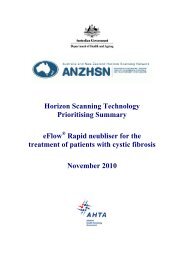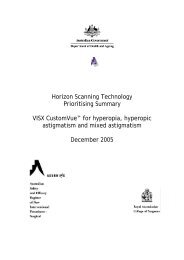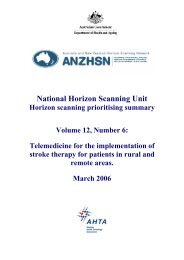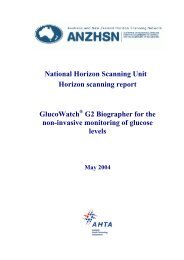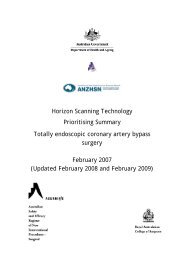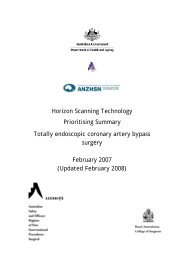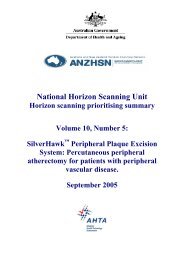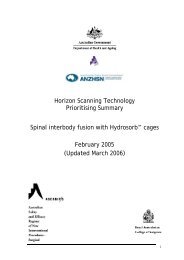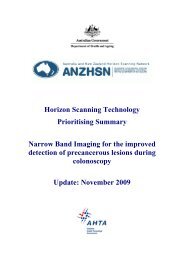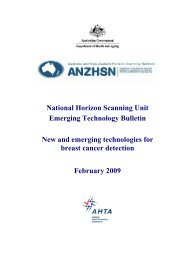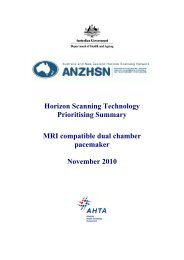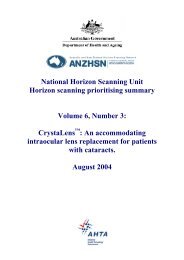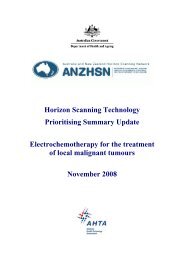Gynecare TVT Obturator System for the treatment of female stress ...
Gynecare TVT Obturator System for the treatment of female stress ...
Gynecare TVT Obturator System for the treatment of female stress ...
You also want an ePaper? Increase the reach of your titles
YUMPU automatically turns print PDFs into web optimized ePapers that Google loves.
National Horizon Scanning Unit<br />
Horizon scanning prioritising summary<br />
Volume 3, Number 9:<br />
<strong>Gynecare</strong> <strong>TVT</strong> <strong>Obturator</strong> <strong>System</strong>:<br />
Treatment <strong>of</strong> <strong>female</strong> <strong>stress</strong> urinary<br />
incontinence.<br />
January 2004
© Commonwealth <strong>of</strong> Australia 2005<br />
This work is copyright. You may download, display, print and reproduce this material in<br />
unaltered <strong>for</strong>m only (retaining this notice) <strong>for</strong> your personal, non-commercial use or use within<br />
your organisation. Apart from any use as permitted under <strong>the</strong> Copyright Act 1968, all o<strong>the</strong>r rights<br />
are reserved. Requests and inquiries concerning reproduction and rights should be addressed to<br />
Commonwealth Copyright Administration, Attorney General’s Department, Robert Garran<br />
Offices, National Circuit, Canberra ACT 2600 or posted at http://www.ag.gov.au/cca<br />
Electronic copies can be obtained from http://www.horizonscanning.gov.au<br />
Enquiries about <strong>the</strong> content <strong>of</strong> this summary should be directed to:<br />
HealthPACT Secretariat<br />
Department <strong>of</strong> Health and Ageing<br />
MDP 106<br />
GPO Box 9848<br />
Canberra ACT 2606<br />
AUSTRALIA<br />
DISCLAIMER: This summary is based on in<strong>for</strong>mation available at <strong>the</strong> time <strong>of</strong> research and<br />
cannot be expected to cover any developments arising from subsequent improvements to health<br />
technologies. This summary is based on a limited literature search and is not a definitive<br />
statement on <strong>the</strong> safety, effectiveness or cost-effectiveness <strong>of</strong> <strong>the</strong> health technology covered.<br />
The Commonwealth does not guarantee <strong>the</strong> accuracy, currency or completeness <strong>of</strong> <strong>the</strong><br />
in<strong>for</strong>mation in this summary. This summary is not intended to be used as medical advice and it is<br />
not intended to be used to diagnose, treat, cure or prevent any disease, nor should it be used <strong>for</strong><br />
<strong>the</strong>rapeutic purposes or as a substitute <strong>for</strong> a health pr<strong>of</strong>essional's advice. The Commonwealth<br />
does not accept any liability <strong>for</strong> any injury, loss or damage incurred by use <strong>of</strong> or reliance on <strong>the</strong><br />
in<strong>for</strong>mation.<br />
The production <strong>of</strong> this Horizon scanning prioritising summary was overseen by <strong>the</strong> Health Policy<br />
Advisory Committee on Technology (HealthPACT), a sub-committee <strong>of</strong> <strong>the</strong> Medical Services<br />
Advisory Committee (MSAC). HealthPACT comprises representatives from health departments<br />
in all states and territories, <strong>the</strong> Australia and New Zealand governments; MSAC and ASERNIP-S.<br />
The Australian Health Ministers’ Advisory Council (AHMAC) supports HealthPACT through<br />
funding.<br />
This Horizon scanning prioritising summary was prepared by Adriana Parrella and Tracy Merlin<br />
from <strong>the</strong> National Horizon Scanning Unit, Adelaide Health Technology Assessment, Department<br />
<strong>of</strong> Public Health, Mail Drop 511, University <strong>of</strong> Adelaide, South Australia, 5005.
REGISTER ID: 0000058<br />
PRIORITISING SUMMARY<br />
NAME OF TECHNOLOGY:<br />
PURPOSE AND TARGET GROUP:<br />
GYNECARE <strong>TVT</strong> OBTURATOR SYSTEM<br />
TREATMENT OF FEMALE STRESS URINARY<br />
INCONTINENCE<br />
STAGE OF DEVELOPMENT (IN AUSTRALIA):<br />
Experimental Established<br />
⌧ Investigational Established but changed indication<br />
or modification <strong>of</strong> technique<br />
Nearly established Should be taken out <strong>of</strong> use<br />
AUSTRALIAN THERAPEUTIC GOODS ADMINISTRATION APPROVAL<br />
Yes ARTG number<br />
⌧ No Not applicable<br />
INTERNATIONAL UTILISATION:<br />
COUNTRY<br />
Trials Underway or<br />
Completed<br />
Belgium<br />
<br />
LEVEL OF USE<br />
Limited Use<br />
Widely Diffused<br />
IMPACT SUMMARY:<br />
ETHICON, INC. (Johnson and Johnson) have developed <strong>the</strong> GYNECARE <strong>TVT</strong> <strong>Obturator</strong><br />
<strong>System</strong> with <strong>the</strong> aim <strong>of</strong> treating <strong>female</strong> <strong>stress</strong> urinary incontinence. The technology is currently<br />
not available in Australia. The <strong>Obturator</strong> <strong>System</strong> includes new, additional features to <strong>the</strong> currently<br />
available GYNECARE <strong>TVT</strong> device. FDA Approval to market <strong>the</strong> device was given in early<br />
December 2003 (FDA, 2004).<br />
Indications are <strong>for</strong> <strong>the</strong> <strong>treatment</strong> <strong>of</strong> <strong>stress</strong> urinary incontinence (SUI) resulting from urethral<br />
hypermobility and/or intrinsic sphincter deficiency.<br />
The GYNECARE <strong>TVT</strong> <strong>Obturator</strong> <strong>System</strong> uses a minimally invasive approach to rein<strong>for</strong>ce <strong>the</strong><br />
structures supporting <strong>the</strong> urethra. It allows <strong>for</strong> an “inside-out” technique to insert a polypropylene<br />
tape through <strong>the</strong> obturator <strong>for</strong>amens, underneath <strong>the</strong> urethra, creating a supportive sling. The tape<br />
is positioned without tension under <strong>the</strong> junction between <strong>the</strong> mid and distal urethra. This<br />
technique avoids <strong>the</strong> retropubic space (unlike conventional <strong>TVT</strong> procedures) and <strong>the</strong>re<strong>for</strong>e<br />
reduces <strong>the</strong> potential <strong>for</strong> urethral and bladder injury associated with some standard <strong>TVT</strong><br />
procedures. Specifically designed instruments in <strong>the</strong> GYNECARE <strong>TVT</strong> <strong>Obturator</strong> <strong>System</strong> include<br />
a pair <strong>of</strong> metallic “helical passers”, plastic tubes and an introducer.<br />
The study outcomes <strong>of</strong> 107 consecutive patients treated with <strong>the</strong> GYNECARE <strong>TVT</strong> <strong>Obturator</strong><br />
<strong>System</strong> in Belgium, between March 2002 and February 2003, focus on immediate complication<br />
rates and do not assess incontinence or de novo urgency rates. The follow up time was short (one<br />
1
month). This study (level IV evidence) included 74 patients with SUI and 33 patients with pelvic<br />
organ prolapse requiring surgical correction, who <strong>the</strong>n underwent <strong>the</strong> modified <strong>TVT</strong> procedure.<br />
There were no peri-operative complications such as injury to <strong>the</strong> urethra, vagina, bladder, nerves,<br />
bowel or significant bleeding (>100ml). One month after <strong>the</strong> procedure three patients (2.8%) (2 <strong>of</strong><br />
<strong>the</strong> 33 patients with prolapse and 1 <strong>of</strong> <strong>the</strong> 74 patients with SUI only) had complete urinary<br />
retention and required a tape release procedure with local anaes<strong>the</strong>tic injection and intravenous<br />
sedation. None <strong>of</strong> <strong>the</strong>se patients re-developed incontinence or a fistula. Mean operative time was<br />
14 minutes and mean hospital stay was 1.8 days <strong>for</strong> patients with transobturator inside-out<br />
operations only.<br />
The study authors are currently conducting fur<strong>the</strong>r prospective studies in cohorts <strong>of</strong> patients with<br />
isolated SUI.<br />
Australian community-based studies have reported incontinence in 19% <strong>of</strong> women aged 10-29<br />
years, 40% <strong>of</strong> women aged 30-44 years, 50% <strong>of</strong> women aged 45-59 years, 30% <strong>of</strong> women aged<br />
60-74 years, and 42% <strong>of</strong> women aged over 75 years (Millard, 1998). In 1998 <strong>the</strong> cost <strong>of</strong> urinary<br />
incontinence in 1,835,628 community-dwelling women over <strong>the</strong> age <strong>of</strong> 18 years was estimated at<br />
$710 million, or $387 per incontinent woman, comprising $338 million in <strong>treatment</strong> costs and<br />
$372 million in personal costs (Doran et al. 2001). An estimated 60% <strong>of</strong> <strong>the</strong> Australian women<br />
with incontinence in 1998 were aged 40 years or over and <strong>the</strong> authors projected <strong>the</strong> total annual<br />
cost <strong>of</strong> incontinence in 20 years' time would be $1268 million. However, this cost may be an<br />
underestimate as <strong>female</strong> incontinence is <strong>of</strong>ten a hidden problem, with women <strong>of</strong>ten not seeking<br />
<strong>treatment</strong> due to a perceived stigma.<br />
The total number <strong>of</strong> urinary incontinence sling (<strong>TVT</strong> and o<strong>the</strong>r) procedures recorded by <strong>the</strong> HIC<br />
(item number 35599) between July 2002 and June 2003 was 3,360. The MBS fee was $560.55<br />
(HIC, 2003). The total number <strong>of</strong> o<strong>the</strong>r <strong>stress</strong> incontinence procedures recorded by <strong>the</strong> HIC (item<br />
numbers 35600, 35602, 35605) between July 2002 and June 2003 was 685. MBS fees <strong>for</strong> <strong>the</strong>se<br />
procedures were $435.15, $560.55 and $304.10 respectively.<br />
CONCLUSION:<br />
There is limited evidence available assessing <strong>the</strong> safety and effectiveness <strong>of</strong> <strong>the</strong> GYNECARE<br />
<strong>TVT</strong> <strong>Obturator</strong> <strong>System</strong>, however it is predicted that <strong>the</strong>re would be a rapid uptake <strong>of</strong> this<br />
technology in <strong>the</strong> Australian public health system.<br />
HEALTHPACT ACTION:<br />
It is <strong>the</strong>re<strong>for</strong>e recommended that this technology be monitored.<br />
SOURCES OF FURTHER INFORMATION:<br />
De Leval, J. (2003). 'Novel surgical technique <strong>for</strong> <strong>the</strong> <strong>treatment</strong> <strong>of</strong> <strong>female</strong> <strong>stress</strong> urinary<br />
incontinence: transobturator vaginal tape inside-out', Eur Urol, 44 (6), 724-730.<br />
Doran, C. M., Chiarelli, P. &Cockburn, J. (2001) 'Economic Costs <strong>of</strong> Urinary Incontinence in<br />
Community-dwelling Australian Women", Med J Aust, 174 (9) 456 - 458<br />
Millard R. (1998) 'The prevalence <strong>of</strong> urinary incontinence in Australia', Aust Continence J 1998;<br />
4: 92-99.<br />
2
SEARCH CRITERIA TO BE USED:<br />
Stress Urinary Incontinence<br />
Transobturator<br />
Urethra<br />
Suspension<br />
3



